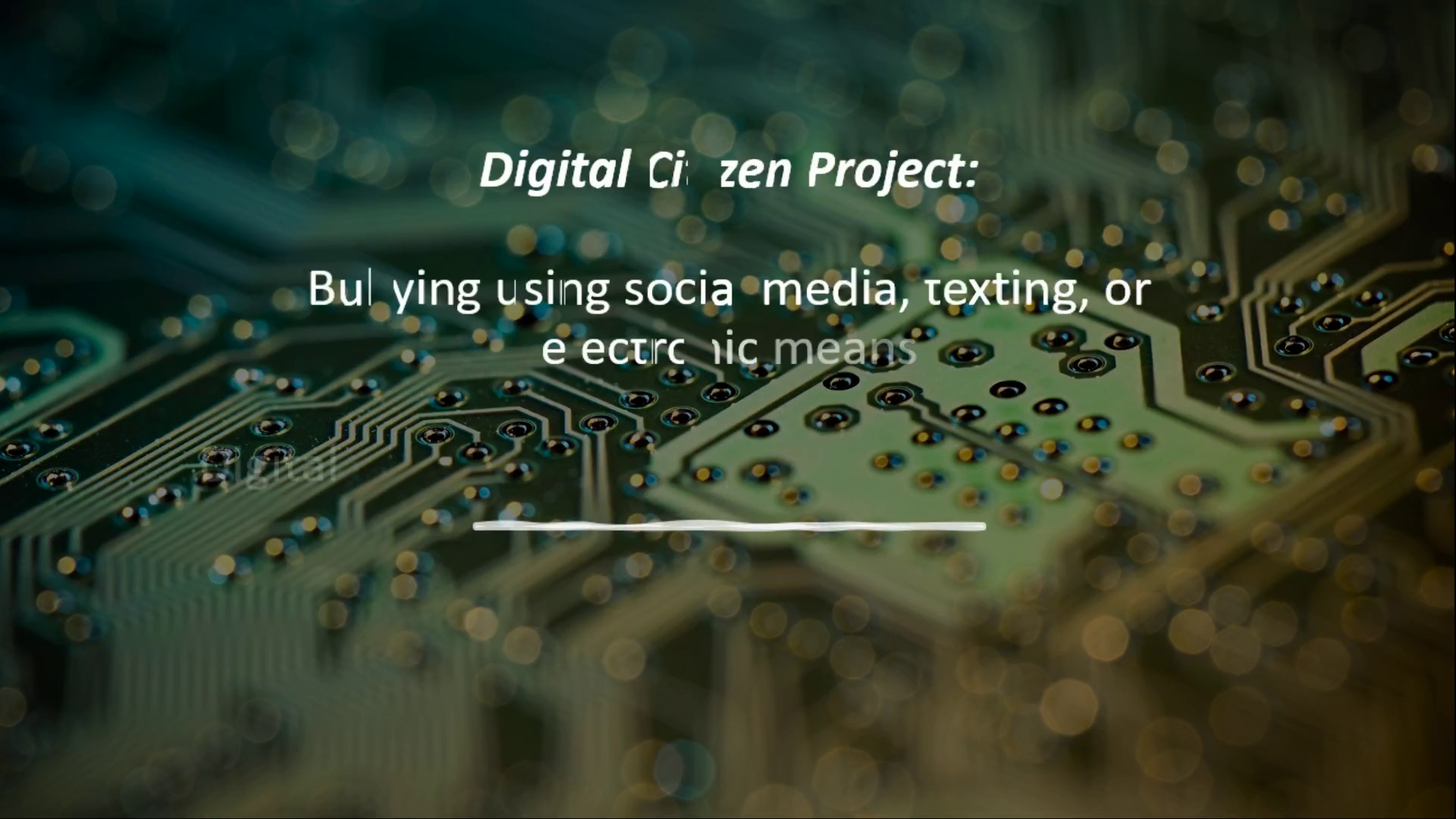
Page 1 (0s)
A computer circuit board. Digital Citizen Project: Bullying using social media, texting, or electronic means Digital security, including issues of cybersecurity.
Page 2 (35s)
Audio Recording Oct 1, 2022 at 10:31:43 AM. Cyberbullying What is it?.
Page 3 (45s)
Audio Recording Oct 1, 2022 at 10:37:26 AM. Issues in Cyberbullying.
Page 4 (1m 14s)
Audio Recording Oct 1, 2022 at 10:55:46 AM. How do we handle this new modern form of bullying?.
Page 5 (1m 25s)
Audio Recording Oct 1, 2022 at 10:57:35 AM. How would you bring up the subject of Cyberbullying to your students or kids? As a teacher, what do you feel are the best repercussions for those found guilty or those who confessed to cyberbullying? Do you think the punishment should be the same for traditional bullying and cyberbullying? With the use of technology in classrooms and homes a constant, how do you as a teacher try to avoid cyberbullying?.
Page 6 (1m 56s)
Audio Recording Oct 1, 2022 at 10:58:10 AM. Digital Security.
Page 7 (2m 5s)
Audio Recording Oct 1, 2022 at 11:04:20 AM. Icon Description automatically generated.
Page 8 (2m 41s)
Audio Recording Oct 1, 2022 at 11:05:59 AM. According to the FBI’s Internet Crime Complaint Center (IC3) a reported 2.7 Billion Dollars was stolen in cybercrimes just last year..
Page 9 (3m 4s)
Digital Literacy as a Citizenship Right. Challenges.
Page 10 (4m 13s)
Challenge 1: Immaturity and Naiveté. Nearly one-half of teens interfere with their own learning by multitasking with social media while doing their homework. Researchers at Stanford found that 82 percent of middle schoolers can’t distinguish between an ad labeled “sponsored content” and a real news story on a website. Schools can play a critical role by educating, empowering and engaging children with the best practices around technology use..
Page 11 (5m 37s)
Opportunity 1: Understanding Expanded. A vast array of knowledge and resources available online, coupled with the ability to connect instantaneously with peers and educators, make for highly engaging and collaborative learning environments. Students can pursue their interests and find educational resources and experiences online any time, any place and at any pace..
Page 12 (6m 18s)
Students often believe they have no control over who is able to contact them through social media and what is posted on their personal pages. Many children will remain silent because they are embarrassed and afraid their parents will overreact. The idea that their parents will engage with the other child, speak to other parents, or take away their devices is terrifying to them, so they do not say anything to an adult when cyberbullying happens. Also, children may not know that they have the power to block a person who is contacting them through technology. They do not have to passively accept the bullying. Whether it is on their phones or through social media they can choose to block the person so that they no longer need to deal with the bullying messages when they are safe at home. Parents and other trusted adults need to speak about cyberbullying openly and calmly with children. Adults should know that the best way to combat cyberbullying is to remain calm and understanding and communicate with children often. Adults need to make sure children know that they have control over who can contact them, that they are not alone, and that they should always let an adult know when cyberbullying occurs..
Page 13 (7m 35s)
Bullying using social media, texting, or other electronic means.
Page 14 (8m 51s)
There are different ways to cyberbully, but some of the most common are: Posting comments or rumors about someone that are mean, hurtful, or embarrassing. Threatening to hurt someone or telling them to kill themselves. Posting a mean or hurtful picture or video Pretending to be someone else online in-order to solicit or post personal or false information about someone else. Posting mean or hateful names, comments, or content about any race, religion, ethnicity, or other personal characteristics online. Creating a mean or hurtful webpage about someone. Doxing, an abbreviated form of the word documents, is a form of online harassment used to exact revenge and to threaten and destroy the privacy of individuals by making their personal information public, including addresses, social security, credit card and phone numbers, links to social media accounts, and other private data. There are other ways out there that cyberbullying can be done, but these are some of the most common forms that parents and students should be aware of..
Page 15 (10m 5s)
Challenge 2: Digital Actions cause Physical Harm.
Page 16 (11m 3s)
Opportunity 2: Make better citizens. Children’s social relationships seem to be enhanced by digital technology, especially since most of their social circle is now online. Educators are crucial to helping young people assess reliable news and information sources and navigate the pressures social media. Children at the forefront of national and global digital policies, not only to protect them from online harm but also to allow technology to help them fulfil their full potential..
Page 17 (11m 36s)
A challenge for users can be learning how to recognize legitimate information from phishing. Scammers can use email, text, or even social media in phishing attacks. These attacks are used to gather the users personal information, phishing attacks on social media is used not only to steal personal information but to gain access to the users social media account. The problem with these attacks are they are made to look like legitimate sites and information so many users have a hard time recognizing them. Phishing emails and texts may look like they are from a company you know or trust. Scammers often update their tactics, but there are some signs that will help you recognize a phishing attacks..